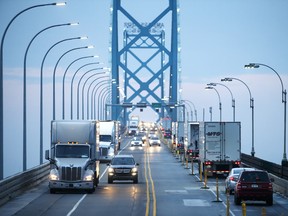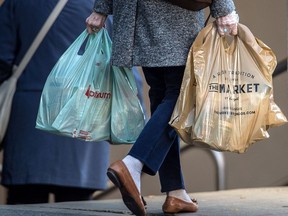Ottawa should be treating food system as a top priority amid climate change
Article content
Climate change is threatening to make traditional farming a lot harder, which is why some agriculture leaders are pushing the federal government to start treating the national food system as a top priority.
Advertisement
This advertisement has not loaded yet, but your article continues below.
Article content
The Ottawa-based Canadian Agri-Food Policy Institute (CAPI) wants Prime Minister Justin Trudeau’s next cabinet to adopt a new strategic plan around agriculture and the climate crisis, amid concerns that extreme weather events such as this summer’s devastating drought in Western Canada could become more commonplace around the world.
“There’s a long list of actions that need to happen, but, first and foremost, it is that recognition that agriculture matters,” CAPI managing director Tyler McCann said in an interview last week. “Agriculture is a driver of the future of Canada.”
Some foreign growing regions could become inhospitable for crops in the future, but Canada’s agricultural potential, McCann said, could grow if global warming persists.
Advertisement
This advertisement has not loaded yet, but your article continues below.
Article content
“We need to really unlock that potential to produce more food to feed the world, but to do it in a way that doesn’t destroy the world as we’re feeding it,” he said.
But Lenore Newman, director of the Food and Agriculture Institute at the University of the Fraser Valley in Abbotsford, B.C., isn’t as optimistic about the potential for Canadian farming in a warmer world.
Agriculture is a driver of the future of Canada
Tyler McCann, CAPI managing director
“It was 42 C in downtown Vancouver this summer. I can’t farm if it’s 42 C,” she said. “The weather is getting more and more unpredictable … There are no winners with climate change.”
CAPI released a “transition binder” ahead of last week’s election to help guide the yet-to-be-named federal agriculture minister through the top issues facing the industry. The minister’s job is “no longer considered a junior ministry,” veteran agriculture executive and CAPI board member Kim McConnell wrote in the document.
Advertisement
This advertisement has not loaded yet, but your article continues below.
Article content
CAPI is positioning the agriculture industry as a key growth area to drive the post-pandemic recovery, arguing that the country needs a “more resilient agri-food system that produces more and better, sustainably and profitably, to meet consumers’ growing needs and wants in Canada and around the world.”
A report by the federal Agri-Food Economic Strategy Table laid out an ambitious vision of Canada being one of the world’s five biggest agri-food competitors by 2025. The report said the sector could grow its global exports to $85 billion by 2025, up from $64.6 billion in 2017, in part by expanding the food-processing industries and boosting exports of value-added products, rather than just raw commodities.
Advertisement
This advertisement has not loaded yet, but your article continues below.
Article content
But to dramatically boost food production and processing while also reducing the agriculture industry’s emissions will take more innovation, McCann said, and the best way to do that is by having the government partner with private-sector players to fund the development of new technology.
The federal government already has some experience with that through its Superclusters Initiative, which used public funding to establish innovation hubs in five promising sectors.
One of the most successful superclusters, Protein Industries Canada (PIC), has helped attract multi-million-dollar investments for technologies and facilities that process pulse crops, including peas and beans, into ingredients for meatless hamburgers and a range of other products in the fast-expanding plant-based protein market.
Advertisement
This advertisement has not loaded yet, but your article continues below.
Article content

This week, PIC released a plan, The Road to $25 Billion, to achieve the Canadian industry’s ambition of capturing 10 per cent of the global market and hitting $25 billion in sales by 2035.
“I don’t think there’s anything wrong with picking industries that are winners, like agriculture and food,” said PIC chief executive Bill Greuel.
But industry leaders said the industry needs some basic infrastructure upgrades before there can be more innovation and excellence hubs.
Canadian Federation of Agriculture president Mary Robinson said one of the most glaring needs is still high-speed internet access in rural regions, despite a 2020 federal pledge to blanket the country with broadband by the end of the decade.

Severe heat, drought slash canola crop harvest to smallest in 9 years

These two farming methods can feed the planet and help the environment — but they need to get along

The rise of indoor farming is exploding, but Canada is lagging behind

rowing up: The next frontier in farming is vertical and it could cut Canada’s reliance on imported food
“We continue to wait for broadband,” she said. “Not a lot has changed … Our priority issues are fairly consistent — that might speak to how well they’ve been addressed.”
Poor internet access alone can seriously limit the potential of farms, she said, making the quality of life worse for farm workers and exacerbating the sector’s chronic labour shortages.
“If you ever sit in on a Zoom call with ag leaders across the country, you’re going to find that a lot of people freeze up,” she said.
Financial Post
• Email: jedmiston@postmedia.com | Twitter: jakeedmiston
Advertisement
This advertisement has not loaded yet, but your article continues below.
Next cabinet needs to get serious about food, agriculture leaders say
2021-09-27 15:11:35






